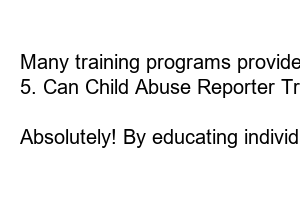아동학대 신고의무자 교육
Title: Child Abuse Reporter Training: Empowering Individuals to Protect Our Children
Introduction:
Child abuse is a grave societal issue that demands urgent attention. To combat this menace effectively, it is crucial to equip individuals with the necessary knowledge and skills to identify, report, and prevent child abuse. This blog post explores the significance of Child Abuse Reporter Training, shedding light on its objectives, methodologies, and impact.
1. What is Child Abuse Reporter Training?
Child Abuse Reporter Training is a comprehensive program designed to educate individuals on identifying signs of child abuse, understanding their legal obligations, and empowering them to report suspicions to the appropriate authorities promptly. It aims to create a network of informed individuals who can act as the first line of defense for vulnerable children.
2. Understanding the Importance of Early Detection
By providing participants with a deep understanding of the physical, emotional, and behavioral signs of child abuse, training enables them to identify vulnerable children in their communities promptly. *Early detection is crucial* as it allows for timely interventions, potentially preventing further harm and facilitating the child’s path to recovery.
3. The Role of Training in Breaking the Cycle of Abuse
Child Abuse Reporter Training plays a pivotal role in breaking the cycle of abuse. By teaching individuals effective intervention strategies and encouraging them to report concerns, the training helps disrupt the silent suffering endured by many children. *It empowers individuals to become advocates for change*, ensuring that child abuse is not ignored or accepted within society.
4. Building Trust and Collaboration
Training programs also emphasize the importance of building trust and collaboration with professionals who specialize in child welfare. By establishing connections between participants and social workers, educators, and law enforcement agencies, the training promotes a coordinated approach to child protection. *Collaboration between all stakeholders is vital* to ensure that children receive the support and services they need to heal and thrive.
5. The Impact of Child Abuse Reporter Training
Child Abuse Reporter Training has significant positive impacts on communities. It amplifies awareness and educates participants about the legal and moral obligation to report abuse. *Informed communities are better equipped* to break the silence surrounding child abuse and create an environment where children feel safe and supported.
6. Strengthening Communities and Safe Spaces
Through Child Abuse Reporter Training, communities are strengthened by their commitment to child protection. It encourages participants to create safe spaces where children can freely voice their concerns and receive the assistance they deserve. *Safe communities foster prevention and support systems* that protect children from abuse and enable their overall well-being.
Summary:
In conclusion, Child Abuse Reporter Training is a vital tool in the fight against child abuse. By equipping individuals with the knowledge, skills, and confidence to identify and report abuse, it creates a network of community advocates committed to protecting vulnerable children. Through early detection, collaboration, and increased awareness, communities become safer, enabling children to flourish free from the shadows of abuse.
FAQs:
1. Who can participate in Child Abuse Reporter Training?
Child Abuse Reporter Training programs are open to anyone interested in becoming an advocate for child protection, including parents, caregivers, educators, and community members.
2. How long does the training typically last?
Training duration may vary, but most programs offer comprehensive courses that can be completed in a few days or spread out over several weeks.
3. Are there any certification or accreditation programs available for Child Abuse Reporter Training?
Yes, some organizations offer certifications upon completion of their training programs, recognizing individuals as trained reporters of child abuse.
4. Is ongoing support available after the training?
Many training programs provide ongoing support, networking opportunities, and access to resources to ensure individuals continue to stay informed and engaged in their role.
5. Can Child Abuse Reporter Training be conducted online?
Yes, with the advancement of technology, many training programs now offer online options, allowing participants to learn at their own pace and convenience.
6. Can Child Abuse Reporter Training make a real difference?
Absolutely! By educating individuals and fostering a network of advocates, Child Abuse Reporter Training has proven to be a critical tool in protecting children, breaking the cycle of abuse, and building safer communities.

